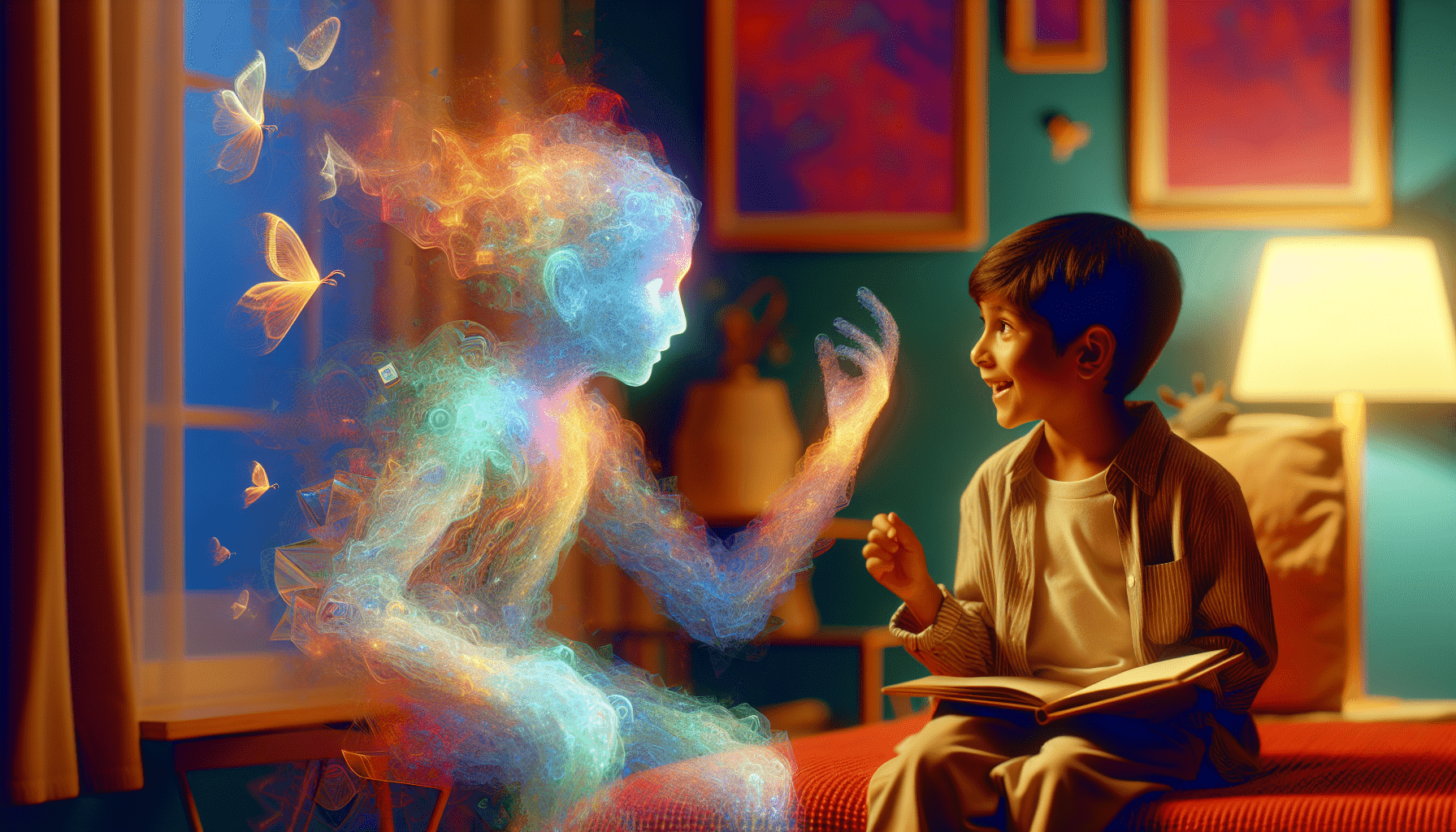
Do you remember the days when your child’s playtime included an invisible best friend? Or perhaps your own childhood was filled with adventures alongside an imaginary companion? You’re not alone. This phenomenon is neither bizarre nor rare. Imaginary friendships can be quite common among children, and something that stirs the curiosity of parents and even researchers. So let’s embark on this whimsical journey of understanding why kids weave tales of companionship and delve into the fascinating world of childhood fantasies.

Imaginary Companions: A Glimpse into Childhood Creativity
Imaginary friends are a window into your child’s vivid imagination and boundless creativity. Far from being a mere quirk, they serve as a vital part of childhood development.
Decoding the Forms and Figures
Imagine for a moment, a stuffed animal that acts as a loyal companion or a picture that lights up conversations. These aren’t just toys; they’re animated companions in the mind of a child. A fascinating study done in 2004 highlighted that 65 percent of children have entertained at least one imaginary friend by age seven. These companions vary greatly—a human-like friend, an animal with special powers, or sometimes, as whimsical as a talking milk carton. Each imaginary friend is as unique as the child who creates them.
The Playground of the Mind: What Purpose Do Imaginary Friends Serve?
Why does your child forge such connections with imaginary pals? The reasons are as diverse as the entities themselves, ranging from playfulness to problem-solving.
Navigating Social Seas
In a world where your child is just starting to learn the ropes of social interaction, imaginary friends offer a safe haven. Here, they practice dialogue, explore friendships, and even rehearse conflict resolution without fear of reprisal. It’s a sort of dress rehearsal for real-world interactions, where they learn through trial and error in a consequence-free environment.
The Joy of Make-Believe
At its core, the creation of imaginary friends is driven by a simple, yet compelling motive—fun. Just like how you might enjoy a gripping novel or a thrilling movie, children dive into the stories and scenarios they craft with their imaginary friends. It’s play, in its purest form.

The Social Benefits of Imaginary Friendships
Imaginary friends do more than just entertain. They play a crucial role in social and emotional development.
Practicing Empathy and Understanding
By interacting with their unseen companions, children imbue them with emotions, desires, and personalities. This nurtures the delicate art of empathy. They learn what makes someone happy or sad, how to negotiate and compromise, and, importantly, how to apologize and make amends.
The Role of Conflict and Resolution
Interestingly, every interaction is not sunshine and rainbows. Imaginary friends can argue, disagree, and sometimes, refuse to play. This is not a sign of trouble but an opportunity for the child to navigate the complexities of conflict. They learn that friendship includes disagreements, how to handle being ‘wronged,’ and what it means to be forgiving.
Myths and Misconceptions: Clearing the Air
Misunderstandings abound when it comes to imaginary friends. What tends to be misconstrued is the suggestion that such friends indicate loneliness or emotional hardship.
A Sign of a Healthy Imagination
Contrary to outdated beliefs, having imaginary friends is not indicative of social isolation or emotional issues. Experts have found that children with imaginary companions perform no worse in social settings than those without. In fact, it points to a lively imagination and creative spirit.
Reassurance for Parents
If you’re concerned about your child’s enthusiasm for their non-existent friend, rest easy. Imaginary companionship is a developmentally normal phase. If anything, it signifies an engaged mind exploring ideas, concepts, and social roles.

Understanding the Complex World of Childhood Trauma and Imaginary Friends
While generally benign, imaginary companions can sometimes reflect a child’s response to trauma or stress, serving as powerful coping mechanisms.
A Safe Haven
For children who’ve experienced difficult environments or traumatic events, an imaginary friend can be both a friend and protector. This imaginary bond offers comfort and stability, acting as a confidant during distressing times. While this can sometimes indicate deeper issues, it’s also a testament to the incredible resilience and adaptability of children.
Isolation and Connection During the Pandemic
The increase in imaginary friendships during isolated times, such as the pandemic, underscores their role in connection and stability. Children, cut off from regular social interactions, may have found solace in their creative abilities, filling the void left by physical companions.
Encouraging Healthy Imaginary Play
As a loving parent, you may wonder how best to nurture your child’s imaginative journeys without overstepping boundaries. Here’s how you can support them.
Balancing Reality and Fantasy
Encourage your child’s storytelling abilities but gently remind them of the distinctions between make-believe and reality when appropriate. This helps them enjoy their imaginary play while grounding them in the real world.
Join the Adventure
Engage with your child’s imaginary friends if invited to do so. Participate in their stories and scenarios. This not only validates their imaginative play but also strengthens your bond with them.

Leaving Room for Creative Expression
Imaginary friends are bridges between a child’s inner world and the outside reality. They grow out of the need for companionship, understanding, and simple joy. These unseen pals are emblematic of the unharnessed power of childhood imagination.
Harnessing Creativity
Encourage your child to express their imagination through art, storytelling, and play. Provide them with tools and opportunities to delve into their creative pursuits, intertwining fantasy with learning.
The Transition Beyond Childhood
It’s worth noting that while imaginary friends are more common in young children, their presence can sometimes extend into middle school and occasionally beyond. As children grow older, the nature of these companions often evolves, reflecting more mature thoughts and concerns, until they gradually fade as real-life relationships and responsibilities become more central.
Conclusion: Embrace the Mystical World of Childhood Imagination
In understanding the why behind kids having imaginary friends, you affirm the magic of childhood. These companions, visible or invisible, unlikely or realistic, are more than just figments of fancy. They are integral to children’s social, emotional, and intellectual development.
Next time you hear chatter in what appears to be an empty room, or notice your child whispering to their stuffed bear, remember that you’re witnessing the brilliant dance of a child’s imagination. Encourage this creativity, participate when invited, and celebrate this enchanting part of growing up. After all, imaginary friends aren’t just playmates—they are the anchoring narratives of a child’s blossoming view of the world.

